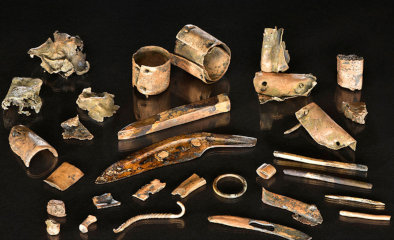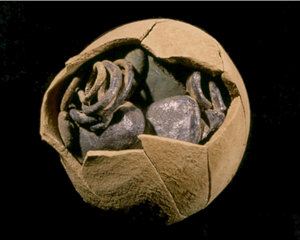Standard Bits
Researchers Nicola Ialongo from the University of Gottingen and Giancarol Lago at Rome's Sapienze University were puzzled. They were studying fragments of bronze that had been recovered from various Bronze Age sites all across Europe - over 3,00 of them - and the majority of them appear to have been deliberately broken from larger bronze objects such as axe-heads or brooches. Why would anyone want to deliberately break pieces off his axe? Or, if they had done so as part of a religious ritual (always an archaeologist's first port of call) why were the pieces so carefully kept instead of being offered to the gods in a bog or similar sacrificial site?

| |
| "Hack bronze" - pieces of bronze deliberately broken to make standard weights. |
In an attempt to solve the mystery the two men started to record every possible detail about their bits of bronze - size, weight, shape, location, and so on. It was the second of these details that suddenly stood out: the smallest of the bronze fragments weighed, on average, 9.8 grams; the next largest averaged at 19.6 grams, then 29.4 grams, and so on. In other words, the larger pieces were multiples of the smallest piece.
Either this was an incredible bit of happenstance or there was some logical explanation behind it. As accident seemed just too improbable and they couldn't think of an even part-way plausible "ritual" reason for it, they reached the conclusion that these bits of bronze were being used to transfer value - that is, they were being used as a form of money!
In the Bible we are told that Abraham purchased the field and cave of Machpelah for 400 shekels.
"Abraham agreed to Ephron’s terms and weighed out for him the price he had named in the hearing of the Hittites: four hundred shekels of silver, according to the weight current among the merchants."
Genesis 23:16
Abraham didn't count out 400 coins, he weighed silver to the equivalent of 400 shekel weights, and as there were differing weights in different places - a problem not unique to Bronze Age Palestine - he used the weights then in use by the merchants of Hebron. Excavations have uncovered numerous sets of weights; in Mesopotamia a popular series was in the shape of ducks. The smallest of these weights, presumed to be a shekel (or "teqel" in Aramaic), weighed 9.6 grams. Other weights identified as shekels by inscriptions on the objects, weighed as much at 17 grams, but the majority were around the 10-11 gram range.

| |
| This woman's gold ribbons survived the death pit at Ur much better than the silver ribbons! |
We may speculate as to why Bronze Age traders and hoarders used bits of bronze instead of bits of more valuable metal, such as silver, but the answer may be that their apparent preference for bronze is a mere artifact of time. When Sir Leonard Woolley was excavating the Death Pits of Ur he found a number of female skulls which had curious purple stains on the bone. It wasn't until he found a woman who, he surmised, had been late for the ceremony and not had time to dress properly, that he found the answer.
The latecomer had a lump of corroded metal at her hip, about where her pocket would have been. When it was cleaned, this turned out to be a tight spiral of silver ribbon. Assuming that the other women were not so dilatory and had adorned their hair with unrolled silver ribbon, that explained the purple stains, for apparently the thin silver had oxidised to nothing but a stain on the bone.
Silver is heavier than bronze, so a tiny fragment of silver weighing only 9.8 grams might well have oxidised to nothing in the years since the Bronze Age and it would be only too easy to overlook a slight purple stain in the soil as you scrape away at the dirt that fills some burial chamber. Nevertheless, a hoard of silver fragments was found in Ebla and the pieces were found to roughly match the system of weights in use in Ebla at that period.

| |
| A broken clay pot from Ebla containing "hack" silver. |
Of course in years to come kings would attempt to facilitate trade by issuing lumps of bronze or silver stamped with their own name as a guarantee that the weight was correct and thus were born coins, which didn't have to be weighed each time you used them. Herodotus claims that the first to do so was King Croesus of Sardis around 560 BC, and the Carthaginians were doing the same thing to pay their troops in Sicily in 410 BC.
What is interesting about the this discovery and theory is the widespread nature of the bronze bits they are studying. Their bits of bronze come from Italy and from Central Europe but there is the possibility that the same phenomenon can be found even further afield. If so, it would point to a standardised system of exchange long before the European Union and its faltering euro! And, of course, if the shekel was indeed meant to be around 10 grams, the same standard would apply across Anatolia and down into Mesopotamia, Palestine and Egypt.
Those Bronze Age people were rather more sophisticated than we have thought, with a common system of exchange that spanned three continents!
Bronze pieces, including a picture of broken bronzes
https://www.sciencedirect.com/science/article/pii/S0305440321000492
Silver pieces, including a picture of a broken pot containing silver pieces
https://www.sciencedirect.com/science/article/pii/S0305440318300025
© Kendall K. Down 2021





